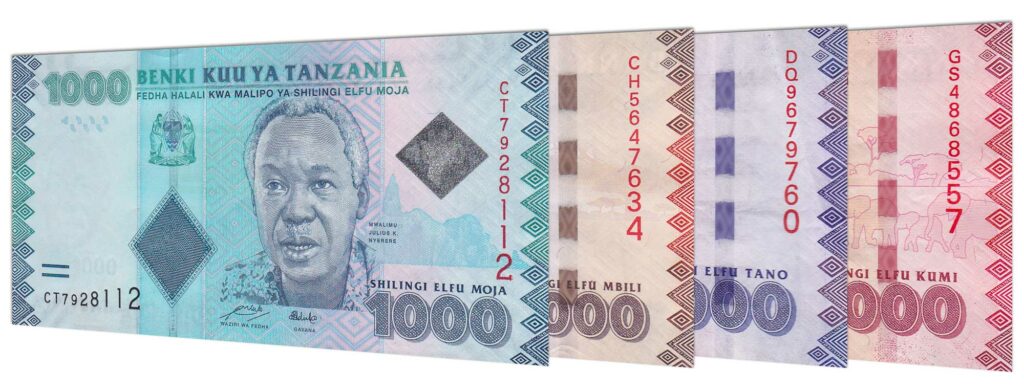Older UK residents may remember the days of the British shilling, a coin phased out during the 1960s and 1970s.
But while the shilling is no longer used in the UK or British Commonwealth countries, one country where it is still very much the main currency is Tanzania.
Five countries in East Africa use the shilling – though Tanzania replaced the generic East African shilling with the Tanzanian shilling in the 1960s.
As one of the many currencies that we accept and exchange here at Leftover Currency, this blog post is dedicated to the Tanzanian shilling – sharing five interesting facts about the currency that falls under the code ‘TZS’ and is abbreviated in writing to ‘TSh’.
1. Tanzanian shillings are referred to using an x/y model
The Tanzanian shilling sometimes uses an “x/y” model in its denomination system. This model is a unique way of referring to currency values.
In this format, “x” represents the number of shillings, and “y” represents the senti, which are cents or smaller units of the shilling.
For example, 500/50 would mean 500 shillings and 50 senti. This system helps specify exact amounts, especially when dealing with smaller denominations.
In addition to this, TSh is used when an amount is being written out. For example, 5 million shillings would be written as TSh 5 million.
It’s a practical and efficient way to handle currency in everyday transactions in Tanzania.
2. Tanzanian notes display the national coat of arms
Tanzania aimed to become more independent by moving away from the East African shilling. This currency was used in British-controlled East Africa from the 1920s until the late 1960s.
It’s a big part of the country’s history. You can see this history on Tanzanian shilling notes. They show the national coat of arms, important places, and significant people. For example, the 1000 Tanzanian Shilling note features Julius Kambarage Nyerere.
He was the Prime Minister of Tanganyika, now mainland Tanzania when it was an independent state from 1961 to 1964.
3. Discovering Tanzania’s Highest Denomination: The 10,000 Shilling Note
For reference, 10,000 TSh equates to about £3.15 in British pounds due to the low exchange rate, (something we will come back to at a later point in this blog).
But imagine for a moment the existence of a £10,000 British note. Imagine holding onto all of that wealth in a single note – it’s a remarkable thought, isn’t it?
In Tanzania, the currency in notes ranges from 500 shillings to 10,000 shillings. Furthermore, in reference to the previous point, the 10,000/= note depicts flowers, an elephant, the national coat of arms, and the Bank of Tanzania headquarters building.
4. The largest coin in circulation equates to 500 shillings
Moving onto the coins of Tanzania, where the largest coin equates to 500 shillings. This coin is made from nickel-plated steel and depicts the first president of Tanzania, Julius Kambarage Nyerere – as well as a bison on the reverse side.
Conversely, the smallest shilling coin in circulation is 50/=.
5. 1 Tanzanian shilling is equal to 0.00031 British pounds
Finally, a little more about the exchange rate between Britain and Tanzania. As one of the most volatile currencies, which is highly affected by the international trading platform and economy, the Tanzanian shilling is currently equal to 0.00031 British pounds (at the time of writing).
For reference, within the local economy of Tanzania, a pint of milk would cost around 780 TSh (780 shillings), and a loaf of bread would cost 450 TSh (450 shillings).
Where can you exchange Tanzanian shillings for British pounds?
The Tanzanian shilling can be difficult to find outside of Tanzania, meaning that those travelling to the country are best waiting until they arrive before exchanging their pounds for shillings.
If you want to exchange TSh back into British pounds, you can do this at some select bureau de change facilities.
Why not skip the hassle and exchange your currency from the comfort of your own home with Leftover Currency? Here, you’re guaranteed the internet-leading exchange rate and a seamless end-to-end service.
Have you encountered any currencies we don’t offer at Leftover Currency?
Here at Leftover Currency, we proudly offer an extensive and ever-growing selection of currencies for conversion and exchange.
If you encounter a currency we don’t exchange on our site, let us know, and we’ll explore adding it to our growing collection!

 Loading
Loading